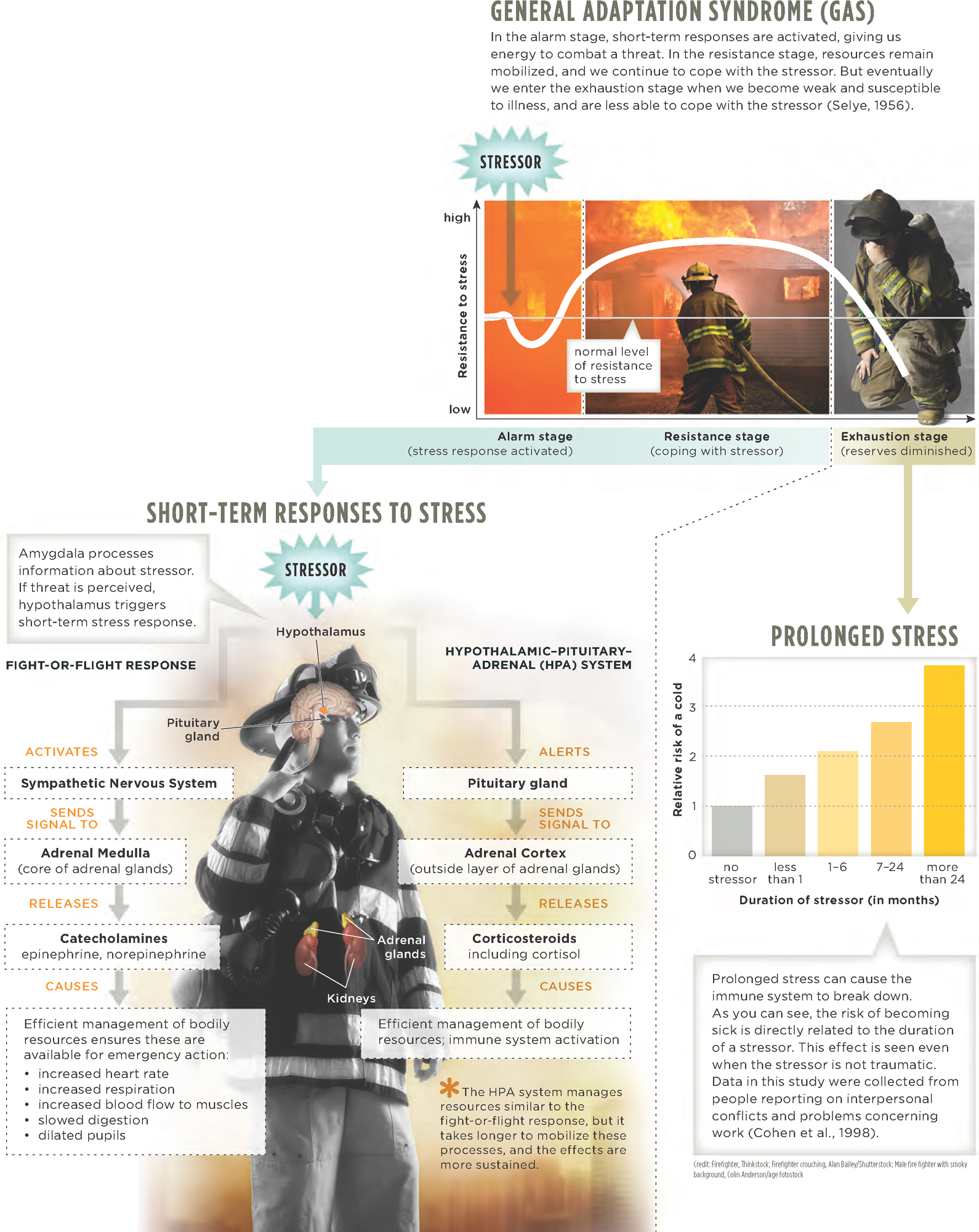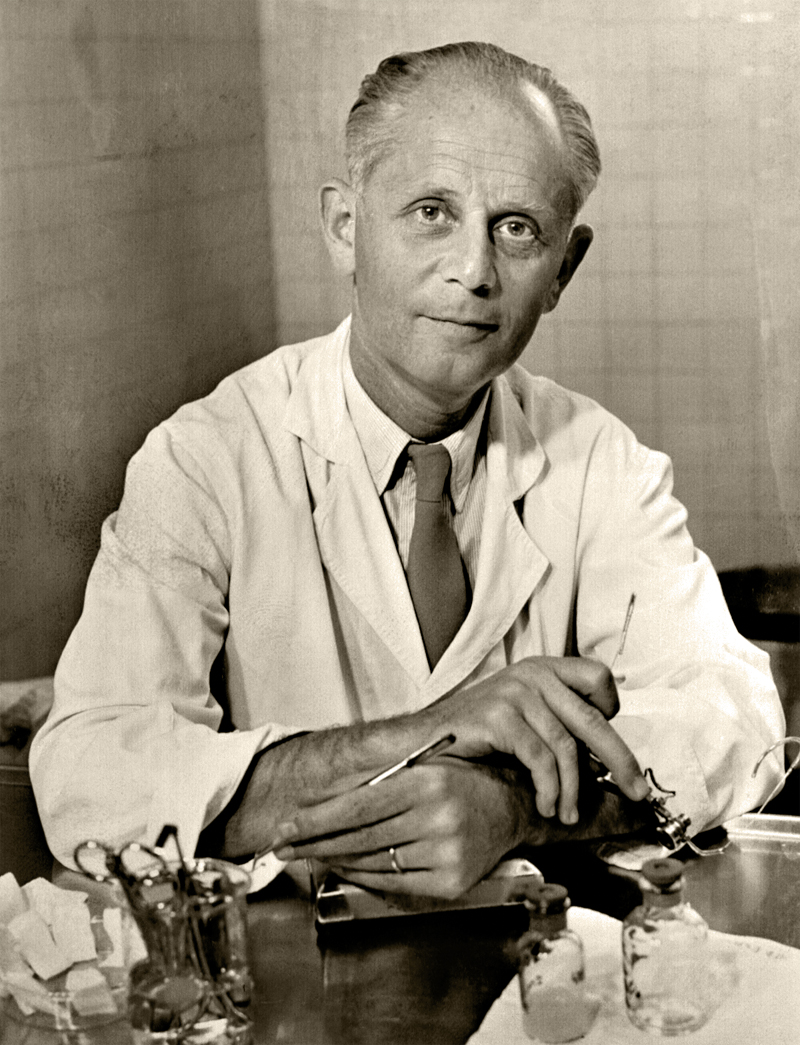12.2 Stress and Your Body
TROUBLE UNDERCOVER
 Meet Sergeant Michelle, a long-time veteran of a police department in a large city at the foot of the Rocky Mountains. Michelle currently works in internal affairs investigating potential policy violations by police officers—a highly stressful position given that the outcome of such investigations can lead to the suspension or termination of fellow officers. But it doesn’t match the intense, fear-for-your-life type of stress that Michelle has experienced at other points in her career, like the time her cover was nearly blown in an operation to bust crack-cocaine dealers. Posing as a buyer, Michelle walked into a house where a suspected dealer was selling. One of the men who happened to be hanging out in the house gave her a funny look, and she instantly realized that he recognized her as a police officer. Fortunately, the man did not give her away (who knows what the dealer would have done had her identity been revealed), and Michelle escaped the situation unscathed. But we can only imagine what she must have felt at that moment.
Meet Sergeant Michelle, a long-time veteran of a police department in a large city at the foot of the Rocky Mountains. Michelle currently works in internal affairs investigating potential policy violations by police officers—a highly stressful position given that the outcome of such investigations can lead to the suspension or termination of fellow officers. But it doesn’t match the intense, fear-for-your-life type of stress that Michelle has experienced at other points in her career, like the time her cover was nearly blown in an operation to bust crack-cocaine dealers. Posing as a buyer, Michelle walked into a house where a suspected dealer was selling. One of the men who happened to be hanging out in the house gave her a funny look, and she instantly realized that he recognized her as a police officer. Fortunately, the man did not give her away (who knows what the dealer would have done had her identity been revealed), and Michelle escaped the situation unscathed. But we can only imagine what she must have felt at that moment.
CONNECTIONS
We introduced the fight-or-flight response to stressors in Chapter 2. The sympathetic nervous system is a division of the autonomic nervous system, which regulates the body’s involuntary activity (such as digestion and the beating of the heart). Here, we will learn how this automatic activity may relate to illness.
Faced with the prospect of being gunned down by a drug dealer, Michelle most likely experienced the sensations associated with the fight-or-flight response, such as increased pulse, breathing rate, and mental alertness. A coordinated effort of the sympathetic nervous system and the endocrine system, the fight-or-flight reaction primes the body to respond to danger, either by escaping (bolting out of the crack house, as in Michelle’s case) or confronting the threat head-on (defending herself against a physical attack). Let’s take a closer look at this survival mechanism.
Fight or Flight
LO 4 Identify the brain and body changes that characterize the fight-or-flight response.
When faced with a threatening situation, portions of the brain, including the hypothalamus, activate the sympathetic nervous system, which leads to the secretion of catecholamines, such as epinephrine and norepinephrine. These hormones cause heart rate, blood pressure, respiration, and blood flow to the muscles to increase. Meanwhile, digestion slows and the pupils dilate.
Physiological responses prepare us for an emergency by efficiently managing the body’s resources. Once the emergency has ended, the parasympathetic system reverses these processes by reducing heart rate, blood pressure, and so on. If a person is exposed to a threatening situation for long periods of time, the fight-or-flight system remains active. This in turn can have detrimental effects on health (Shonkoff et al., 2012), an issue we will explore later in this chapter.
CONNECTIONS
In Chapter 2, we introduced the parasympathetic nervous system, which is responsible for the “rest-and-digest” process following activation of the fight-or-flight response. The parasympathetic nervous system works with the sympathetic nervous system to prepare us for crises and then to calm us when danger has passed.
General Adaptation Syndrome
LO 5 Outline the general adaptation syndrome (GAS).
Hans Selye, introduced earlier in the chapter, identified police work “as likely the most stressful occupation in the world” (according to Violanti, 1992, p. 718). One of the first to suggest the human body responds to stressors in a predictable way, Selye (1936) described a specific pattern of physiological reactions, which he called the general adaptation syndrome (GAS).
516
INFOGRAPHIC 12.1: Physiological Responses to Stress
When faced with an emergency, our bodies go through a series of physiological responses that assist us in coping with a stressor. Activation of the fight-or-flight response and hypothalamic–pituitary–adrenal (HPA) system gives us the energy and resources we need to cope with a temporary stressor. Studying these physiological responses, Hans Selye (1956) suggested that the sequence follows the same path no matter the stressor. He found that when the stressor remains, our bodies can no longer adapt. Selye called this sequence the general adaptation syndrome (GAS).

517
According to this theory, the body passes through three stages (Infographic 12.1). The first is the alarm stage, or the body’s initial response to a threatening situation, similar to the fight-or-flight response. Arousal increases, and the body prepares to deal with the threat. Following the alarm stage is the resistance stage. During this period, the body maintains a high level of arousal (though not as high as that of the alarm stage), but with a decreased response to new stress. Under such intense physiological demands, the body simply cannot address any new threatening situations that might arise. According to Selye, this is when some people start to show signs of diseases of adaptation, such as hypertension and arthritis (Selye, 1953; Selye & Fortier, 1950). If the threat remains and the person can no longer adapt, Selye suggested that the body then moves into the exhaustion stage. At this point, the body’s resources become depleted, resulting in vulnerability to illnesses, physical exhaustion, and even death.

Hypothalamic–Pituitary–Adrenal System
LO 6 Describe the function of the hypothalamic–pituitary–adrenal (HPA) system.
Overseeing the sympathetic nervous system’s response to stress is the hypothalamic–pituitary–adrenal (HPA) system (Infographic 12.1). This HPA system helps to maintain balance in the body by directing not only the sympathetic nervous system, but also the neuroendocrine and immune systems (Ben-Zvi, Vernon, & Broderick, 2009). When a stressful situation arises, the hypothalamus initiates a cascade of responses, by alerting the pituitary gland, which then sends signals to the adrenal cortex, which in turn orders the secretion of corticosteroids, such as cortisol. These hormones summon the immune system to fend off a threat and reduce the amount of energy used for nonessential activities (that is, those not associated with the threat), such as digestion and bladder control. The immune system defends the body from bacteria, viruses, and other types of invaders by deploying cells and chemicals to confront these threats. When faced with a stressor, the HPA system responds in the same way it would to a pathogen—by mobilizing a defense response. You might say it’s working overtime. How do you think this affects your health?
show what you know
Question 12.5
1. According to the ____________, the human body responds in a predictable way to stressors, following a specific pattern of physiological reactions.
Question 12.6
2. As a police officer, Michelle has found herself in life-threatening situations. When faced with danger, Michelle’s body initially exhibits a fight-or-flight reaction, which is equivalent to the ___________ of the general adaptation syndrome.
- alarm stage
- exhaustion stage
- diseases of adaptation
- acculturative stress
Question 12.7
3. ___________ helps maintain balance in the body by overseeing the sympathetic nervous system, as well as the neuroendocrine and immune systems.
- The general adaptation syndrome
- The exhaustion stage
- The hypothalamic–pituitary–adrenal system
- Eustress
Question 12.8
4. Explain the processes that occur in the human body when it is faced with a life-threatening situation.
 CHECK YOUR ANSWERS IN APPENDIX C.
CHECK YOUR ANSWERS IN APPENDIX C.
518